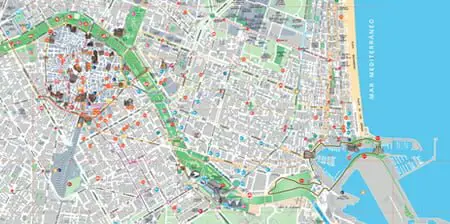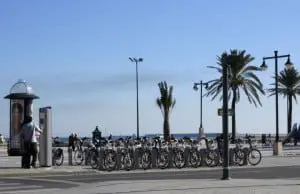Spanish isn’t a very complicated language, although we have to admit that –like in all languages – it’s the verbs that make a student’s life more complicated. If you decide to come to Spain you’re going to recognize these typical spelling mistakes in Spanish. At the latest, when you’re going to improve your spelling. In practice, you´re going to notice that these mistakes happen very quickly. But they can also be corrected very quickly.
There are words and verbs that sound very similar in English, French, Russian and Chinese but they have different meanings. They can even be similar in terms of spelling, but in reality, they’re irrelevant to each other. One can be a verb and the other one a noun. As soon as students start learning Spanish, these typical spelling mistakes normally drive them crazy. Just be patient!
- Haber – A ver – Haver
These words sound the same and the spelling is also pretty similar. It´s one of the most typical spelling mistakes in Spanish when you start to learn Spanish. But where’s the difference?
- ,Haber’ is a verb in the infinitive form. For example:” Va haber una fiesta.” (There’s going to be a party.), “¿Cuándo va haber más comida?” (When is there going to be more food?).
- ,A ver’: refers to an action which is going to happen. It’s related to the verb ,ver’ ( to watch,to see) or rather ,mirar’ (to look (at sth.)). Not to be confused with the verb ,haber’ (to exist). For example:” A ver tu habitación.” (Let´s have a look at your room.), “ A ver como es tu nuevo vestido.” (let’s see what your new dress is like.) “Va a ver que este aprender español no es difícil.” (He/She is going to see that it isn’t difficult to learn Spanish.) J.
- ,Haver’: Doesn’t exist. Every time you want to use the word ,haber’, think of the fact that you spell it with a ,b’ like Barcelona.
- Vaya – Valla – Baya
Another mix of ‘V’,’B’ and also double ‘L’ and ‘Y’. The last two are pronounced the same way. But let’s see what makes the difference:
- Vaya: Goes with the verb, ir. Together with the word, Valla, it forms a homophone
( words that sound the same but with different meanings) . Vaya, with, y, is the first person singular of the subjunctive present of the verb, ir, which means going from one place to another. For example: “ Vaya usted despacio.” (walk more slowly/slow down). “Iré a correr a no ser que vaya a la biblioteca a estudiar.” (I will go running, if I’m not going to library to study.) It’s also used as a superlative or exclamation, “Vaya con este vino, está buenísimo!” (This vine is excellent!)
- Valla: is a substantive, it refers to a fencing which is used to close something or to separate two things. For example: “He colocado una valla para que nadie entre en mi granja.” (I’ve put up a fence so no one can enter my farm.) But it can also mean ,billboard’: “Mira el anuncio de esa valla”. (Look at the advertisement on that billboard.).
- Baya: When you spell it with a B it´s an exotic fruit. In Spain it’s very common, so don’t be afraid to try it!
- Iba – IVA – HIBA
As soon as you start learning Spanish, you´ll notice quickly that the word HIBA doesn’t exist. It´s a woman’s name, but it’s not a very common one. But there’s a difference between IVA with ‘v’ and ‘b’.
- IVA: It’s a tax (Impuesto Valor Añadido) which you can find on the receipt of your purchases or on bills. It’s a tax that is collected by the Spanish government.
- Iba: when it’s spelled with a ‘b’ it comes from the word ´ir´. It´s the first and third person of the past tense. “ Yo iba a la escuela en Londres.” (I went to school in London.), “ Yo iba a ir de vacaciones a Nueva York pero finalemente no pude.” (I was about to spend my holidays in New York but in the end I couldn´t.) “You iba a estudiar matemáticas pero estudié finalmente química.” (I was about to study mathematics, but in the end I decided to study chemistry). You use this word very often when you talk about your life.
- Haya – Halla – Allá – Haiga
This one is not easy. When you’re learning Spanish in Spain, you’re going to notice very quickly that it isn’t very complicated.
- Haya: it comes from the verb ‘haber’ and often appears in the composite form (haya comido, hayan bebido, hayamos dormido).
- Halla: goes with the verb ‘encontrar’. “Este árbol se halla en el monte” (You can find this tree in the mountains.). Nevertheless, we recommend not to make your life more complicated than it already is and to say: “ Este árbol se encuentra en el monte.” Which means the same but it’s easier!
- Allá: it’s also a verb and describes something that is far away. “Allá en París conocí a mi novio.” (Afar in Paris is where I met my boy friend.), “Allá donde fuimos la última vez.” (The place where we went the last time.), “¿Te veo aquí o allá?” (Will we see each other here or there?)
- Haiga: is a word from the old Spanish language and is not used anymore today. So you better forget about it.
- Hay- Ahí – Ay – Ahy
At first, you should know that the word ‘Ahy’ does not exist. So you can ban it from your vocabulary book. But what’s the difference between the other three words?
- ,Ay’ is an expression or a sigh… it shows astonishment or pain.
- Hay: goes with the verb ‘haber’. “Hay mucha gente en este sitio.” (There are a lot of people in this place.”) or “Aquí hay mucha comida para mi.” (There´s a lot of food for me here.)
- Ahí: ‘Allá’ shows that something is far away and the adverb ‘ahí’ shows that something is near. “Ahí están mis amigos.” (There are my friends), “Ahí es donde estuve la semana pasada” (That´s where I went last week.) As soon as you start learning Spanish you can remember this post. We showed you the most frequent spelling mistakes in the language of Cervantes.






